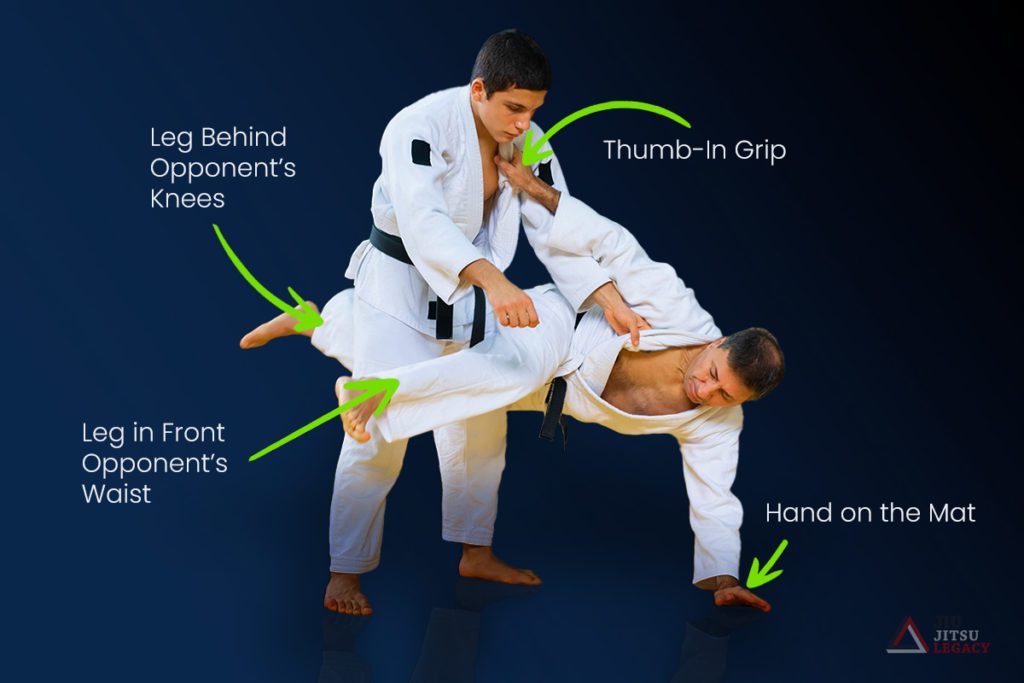Have you ever considered doing something illegal? In BJJ that is. Let’s face it, from time to time everyone gets the itch to try something that’s not exactly by the book. Techniques like the twister and heel hooks are only available today because people did not heed the rules. Well, there’s a black sheep amongst takedowns too that everyone says we should be mortally afraid of.
This technique is called the Kani Basami, also commonly known as the scissor takedown. Keep reading to learn more about this forbidden technique, see what makes it so dangerous, and even learn how to do it (should you dare).
History of the Kani Basami
The Kani Basami is a Judo throw that involves attacking the legs of a standing opponent with your legs by way of a scissoring motion. The end result is a powerful takedown with your opponent landing with their back to the ground – scoring the all-important ippon that wins a Judo match.
The Kani Basami is actually not originally a Judo technique, but rather a Tenshin Shinyo Ryu Jiu Jitsu technique. It was incorporated into Judo very early as Jigoro Kano was putting his system together. The move was a part of the original Kodokan curriculum and was a legal move for use in competition until 1980.
An incident at the 1980 All Japanese Championships, in which a Judoka ended up with a broken fibula (lower leg bone) brought about the initial scissor takedown ban in Judo. After that, the technique was never allowed in Judo competitions again.

As BJJ developed, the Judo ban haunted the Kani Basami, with IBJJF rules making it illegal from day 1. Everyone seemed to find the ban reasonable until the leg lock revolution began around 2014.
As it turns out, there is a scissor takedown variation in Sambo, where it is used to gain access to leg locking positions, rather than just as a takedown. The Danaher Death Squad made the move popular again under ADCC / submission-only rules, where the ban does not apply.
Of course, this called into question the blanket ban on the Kani Basami scissor takedown.
(Flying) Scissor Takedown Mechanics
The Kani Basami is one of the first Judo throws that I was taught as a kid. It was included in Judo curriculums only for the purpose of belt exams. It is an attractive move to watch, which is in part due to the acrobatic nature of the throw.
The throw works by placing one of your legs behind the opponent’s knees and the other in the front of their waist, thus forcing their weight backward. The name “scissor takedown“ comes from the scissoring motion of the legs that puts the opponent off-balance, forcing them to topple backward.
In order to get to such a position, you have to jump into the move, which is why it is sometimes referred to as the flying scissors takedown. In truth, there is very little jumping involved and a lot of very technical positioning behind this move.
To execute the move, you have to be standing sideways in relation to your opponent. If you’re standing to the left of your opponent, your right leg is the one that goes into position first, across the front of the opponent’s waist.
Placing the leg like this provides an anchor that, along with your grips, allows you to swing your other leg in place behind your opponent’s knees.
The grips that allow for the takedown motion to happen without you crashing to the ground start with your right arm gripping the back of their gi collar with a thumb-in grip. The left hand usually holds their sleeve with a cross grip, pulling across your torso. Essentially, you’re standing in a position that is similar to shooting an arrow from a bow.

The acrobatic portion of the move comes after you’ve established the grips. Your goal is to place the front leg in place and immediately jump while pulling yourself into your opponent so that your left leg ends up behind the knees of both the opponent’s legs.
The scissoring motion of the legs, along with your falling body weight, is how this takedown works.
Entries To Kani Basami
Getting to the Kani Basami in Brazilian Jiu Jitsu is easier and a lot more diverse than the original Judo version. The exchanges in BJJ are far more dynamic, allowing for more freedom of motion than Judo.
From Standing
The original Judo setup of the Kani Basami is always an option in BJJ, but it requires a Gi for the grips and thus won’t work in the competitions where the technique is permitted. Instead, we’ve been seeing a lot more scissor takedowns in no-gi Jiu Jitsu, pointing to the fact that there are different, and arguably more effective, ways to set the move up in BJJ.
One example of a high-percentage Kani Basami setup is using it as a counter to the single leg takedown. When an opponent is trying to finish a single leg on you, and you have enough space to circle your shin out from in between their legs, you end up in the initial stage of Kani Basami, with a leg across their waist.
Another solid option for BJJ is to use arm drags or russian ties as ways of forcing your opponent to turn sideways, so you can attack with the scissor takedown. You could also opt for an underhook, which is what Garry Tonon used to get the fastest submission at the 2019 ADCC against Edwin Najmi.
From Guard
As a result of the evolution of the leg lock game in Jiu Jitsu, the Kani Basami has enjoyed something of a revival in the past 7-8 years. Apart from using it as a takedown, people have figured out a variation of it from guard, turning it into a sweep/leg lock entry. Robert Degle is notorious for using it from the bottom, with the butterfly guard being his launching pad of choice.
Degle likes to use both legs to elevate his opponent’s hips, forcing their arm to post over his head. That allows him to remove one of his butterfly hooks and angle his body perpendicular in relation to his opponent, which causes his opponent to land in a Kani Basami variation, opening up leg lock attacks.
What Can You in BJJ With The Kani Basami
If you look at the ending position of the scissor takedown, you’ll notice that you’re already very close to the notorious Honey hole / Saddle / Ashi Garami configuration.
Leg Locks
The scissor takedown, with slight adjustments, offers a myriad of high percentage leg lock finishes. The inside heel hook from the Honeyhole is one example, requiring you to move the leg going across the waist in between the opponent’s legs in order to lock up the triangle.
Alternatively, you could opt for kneebars if your opponent is actively trying to get out.
Sweeps
Takedowns and sweeps share a common trait – both get people‘s hips and or shoulders on the mat while placing you on top of them. The difference is, you do takedowns from standing, and sweeps when you’re on the ground.
Given how effective Kani Basami is as a takedown, and the fact that you can enter into it from BJJ guard positions, means that it doubles as a very reliable sweep option. Usually, people like to go straight for leg locks, but in case those fail, getting out of the Ashi Garami and ending up on top of your opponent will constitute a sweep.
Why Kani Is Basami Dangerous & Illegal
A Look at the Evidence
Analyzing the aftermath of that 1980 incident in Japan, experts came to the conclusion that the potential from injury during a scissor takedown was bigger compared to most other Judo throws. The thinking was that the person on the receiving end won’t stand still when their opponent is trying to execute the move, increasing the chances of the attacker falling out of alignment.
Whenever someone misses the correct placement of the legs, there’s potential for injuries to the standing person’s legs. For example, failing to place the leg across the hips, and having it fall lower along the legs, greatly increases the risk of breaking the knees and/or the shin bones.
Here’s how that initial incident in 1980 looked like (WARNING: graphic):
Taking Precautions
With all that in mind, is the Kani Basami really so dangerous to never be used again in competition? If we go by the old Judo data, then the answer will most likely be Yes. If we let modern data from Jiu Jitsu guide us, the answer is probably No.
The reality is that the Kani Basami used in the exact same situations as it was in the early days of Judo competition is definitely not safe. However, using modified (i.e. evolved) versions of the move is no more dangerous than using any other throw or takedown.
An example of safe usage is setting the Kani Basami from guard positions. By using it as a sweep/leg lock entry, most of the risk associated with falling bodyweight and misalignment is removed.
Even when standing, the Kani Basami can be a safe option. Two things that will greatly reduce the risk of injury, but not affect the effectiveness of the scissor takedown, are focusing on the lead leg, and using an arm to post on the floor before scissoring your legs.
If you take a look at what most leg lockers do, you’ll notice that they’re only going for the close leg, which makes the takedown a lot safer, since one leg stays free.
Moreover, posting the arm on the ground takes away all the risks associated with jumping on your opponent with all of your bodyweight.
The Final Verdict: Still Illegal, but Not Terrifying
After reading all the evidence above, are you still afraid of the Kani Basami takedown? As with most things in BJJ, a bit of common sense, and time spent training a move, all but guarantees that there are no unnecessary risks associated with that move.
Build slowly, start from guards, have fun with the scissor takedown and eventually, when you and your training partners are feeling confident, start practicing from standing. Who knows, the Kani Basami might just end up being removed from the illegal moves list in years to come!
Icons created by Freepik – Flaticon

Ogi is a black belt that does Jiu Jitsu full time and is very passionate about anything grappling-related.
He is also the head coach of Enso Jiu Jitsu in Macedonia and an aspiring Globetrotter.
